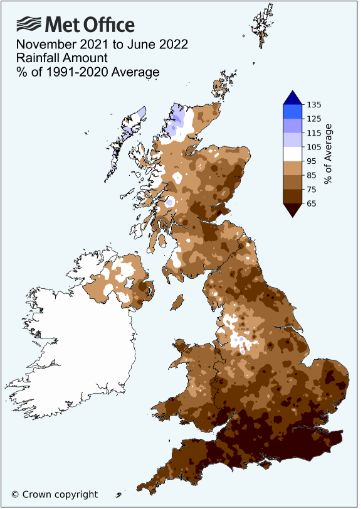
So far July 2022 has been the driest July in England since 1911. Up to 26 July there has been only 15.8mm of rain averaged across England; this is only 24% of the amount we would expect in an average July.
At this stage in the month we would expect to have seen well over three-quarters of the month’s rain to have already fallen in an average July.
The situation for the UK is a little better. As it stands, July 2022 is still the eighth driest July since 1836. With only 37.7mm of rain having fallen so far it is the driest July since 1984. Scotland has been closer to average in the north and west, but drier conditions have prevailed for south and east Scotland. Overall Scotland (71%), Wales (39%) and Northern Ireland (43%) have been dry, but the most extreme conditions are in East Anglia and southeast England.
As frequently happens there is a contrast between the northwest of the UK, where some regions, in the far north of Scotland, have already reached around average rainfall – and the southeast which are looking extremely dry indeed.
Dry month
With a little way to run before the end of the month, there is still time for the situation to shift slightly. However, with little significant rain forecast for south and east England, there is scant prospect of a significant improvement within the next week or two at least. For all July 2022 will be remembered as a dry month and is prompting some in the media to consider the prospect of drought.
Drought isn’t within the Met Office’s remit; instead, the Environment Agency takes the lead on drought in England, with Natural Resources Wales taking responsibility in Wales; NIEA in Northern Ireland and SEPA in Scotland. There are many factors beyond rainfall, such as water demand and the extent of previous rainfall, that drought planners have to consider.
Mark McCarthy, Head of the Met Office National Climate Information Centre, said: “It is not just July that has been dry. Since the start of the year, all months apart from February have been drier than average in the UK too. The result of this is that the winter, spring and summer of 2022 have all seen less than the UK average seasonal rainfall.
“England has seen the lowest levels during these periods and, rainfall totals for the first six months of the year are around 25% below their long-term average, with the driest regions in the east and southeast.”

Drier than 1976?
The lack of rainfall through sequential months and seasons becomes significant when looking back over the years as the 8-month period from November 2021 to June 2022 has been the driest in England since 1975/76, with an average of 421mm of rain falling in England, 74% of the 1991-2020 long-term average of 568 mm.
However, the year so far cannot be compared too closely to 1976, as despite the dry trend England had 30% more rain during the first six months of the year than in 1976. Though the statistics do not necessarily need to be historical to have effects and the Environment Agency has advised ‘There are currently no plans for restrictions on essential water use, we can all do our bit by reducing unnecessary water consumption and following advice from our water company to ensure this remains the case whilst our rivers are exceptionally low.’


Climate change
Mark McCarthy continued: “Met Office climate change projections highlight an increasing trend towards hotter and drier summers for the UK, with the driest regions anticipated to be in the south and east. While trends in summer temperature and heatwaves are very apparent in the climate records of recent decades, the large variability in our rainfall means that it is too soon to be able to detect the pattern in summer rainfall.”
Persistent high pressure has not only brought a lot of dry weather this month, it has also resulted in a warmer month so far too. Since around the 6th temperatures have generally been above average. Heatwave conditions were experienced around 10th-13th and again from the 16th with an exceptional hot spell during the 18th and 19th July. And so early provisional stats for July show, the average maximum temperature across the UK currently stands at 21.5°C, 2°C higher than the UK average for the month and it currently sits within the top five warmest Julys on record. The current warmest July on record was in 2006 when the average maximum temperature for the UK was 23.3°C.
July’s full provisional weather and climate statistics will be published on 1 August.
Via Source link

0 comments:
Post a Comment